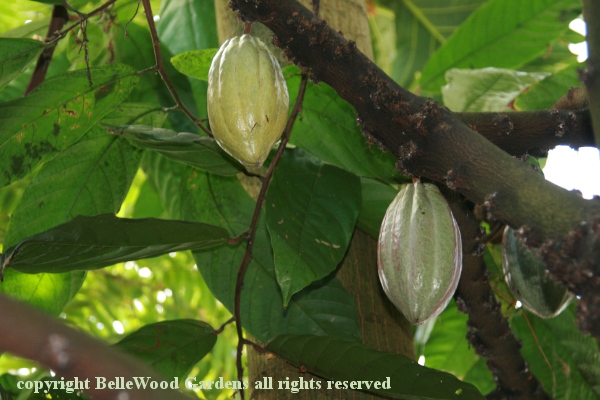
.
If you have any comments, observations, or questions about what you read here, remember you can always Contact Me
All content included on this site such as text, graphics and images is protected by U.S and international copyright law.
The compilation of all content on this site is the exclusive property of the site copyright holder.
We take sweet chocolate for granted - chocolate candy bars, chocolate chip cookies, chocolate layer cakes, brownies, and more. Dark chocolate, milk chocolate, white chocolate. It was not always so. The Aztec, Mayans, Olmec, had cacao, used in a ceremonial drink , but only for royalty, priests, and warriors. The Spanish conquest meant that Cortez was introduced to cacao. But did not like it. What created the change from feh! to fabulous? It's like this (and sugar had a large part to play.)

It starts with cacao, a tropical understory tree that today is grown in a narrow band 10 to 15 degrees on either side of the equator. I saw these green, unripe pods at the New York Botanical Garden in January, when I was there for the Wild Medicine exhibition. The odd looking pods spring directly from majors branches and the trunk of the tree. When ripe, the pods turn orange. The white cacao "beans" are then removed from the pod and fermented, to remove pulp and reduce acidity. Then roasted. The cacao nibs are ground. For cocoa and chocolate they'll be sweetened with sugar and spices such as vanilla and cinnamon.
From Cortez and the conquistadors onward to 18th century America. Colonists were supposed to buy chocolate from England. But port cities such as Philadelphia and Boston would buy the beans and process the cacao themselves. But this can only be done in cool to downright cold weather. Summer heat makes chocolate melt.
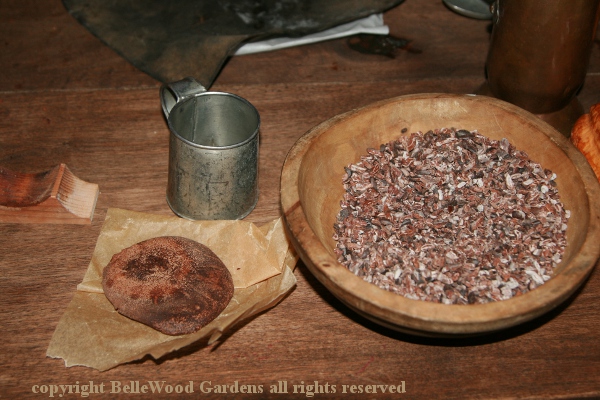
Chocolate "cake' is the firmed up chocolate liquor seen on the left,
which is produced from the cacao nibs seen in the bowl on the right.

The nibs are ground on a granite metate, using a granite roller.
The metal tray underneath the metate holds hot coals to warm it.
I know I said hot weather is not suitable but this is gentle warmth.
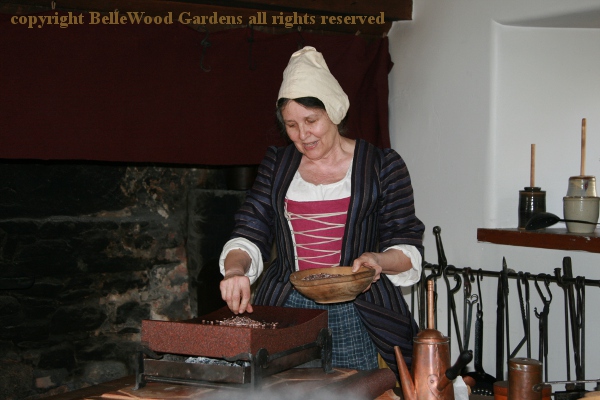
Susan McLellan Plaistead adds cacao nibs to the metate
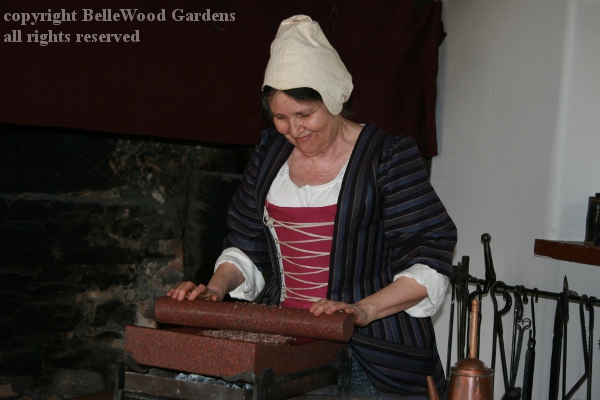
starting to crush them with the granite roller.

See how she is pushing down on the roller.

The crushed nibs soon look more like the chocolate we know.
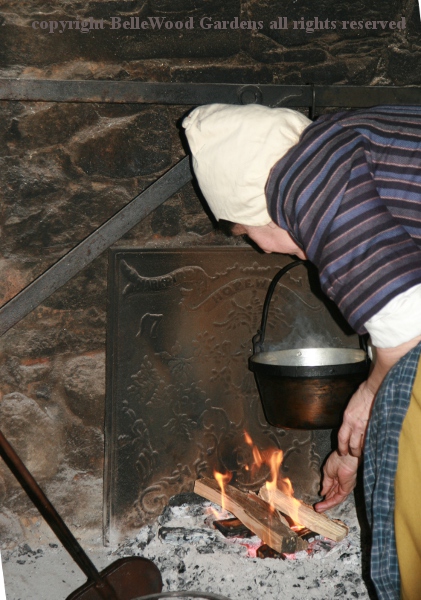
Susan adds wood to the small fire. She is
heating water for the chocolate drink, as
a beverage was how cacao was consumed.

Susan is holding a chocolate pot and a molinillo.
Twirling the molinillo creates a froth, but needs
to be twirled again before each cup is poured.
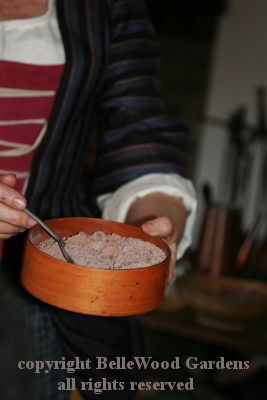
She measures the ground cacao.
Aztec, Olmec, Mayans flavored their
cacao with chilies, achiote, and pepper.
Today, we prefer sugar and vanilla.

Susan adds ground cacao nibs to hot water
that is in the chocolate pot.

The molinillo is fitted through a hole in the lid
and vigorously twirled between Susan's palms.

Cacao beans have been roasted in a dry pan,
stirring all the while to prevent scorching.

The fully crushed nibs would be scraped off the metate and roller, then poured onto a greased paper. The puddle that forms firms up into a cake, to be stored somewhere cool, then crushed as wanted for making a chocolate drink.
Isn't it nice that today our chocolate is so readily available in a diversity of sweet treats without roasting, crushing, frothing, and at any time of year.
UPDATE: A friend in the UK read this entry about 18th century cacao in the United States and mentioned that, "Chocolate crumb, which I assume is the crumbed up cakes, used to be transported by narrow boat along the canals between parts of the Cadbury factory. We went round Bournville quite a few years ago now, and it was very interesting to see how they made the chocolate and the history of it in the UK."
Of course, this piqued my curiosity so I had a quick search for chocolate crumb online. The UK's Meadow Foods site had this to say, "So what is Chocolate Crumb? Essentially, it's a compound ingredient for making dairy milk chocolate as well as a range of chocolate flavoured products. It's made from a blend of Sugar, Dairy Milk and Cocoa Liquor which, when vacuum cooked, can be dried and milled to form a powdered 'crumb' product. This crumb can be quickly and economically incorporated into the manufacturing process." Their chocolate crumb product also has a caramelized note, acquired from the Maillard reaction in preparing the crumb.
"We had the Aztec type drink," my friend also mentioned, "and I think it was flavoured with pepper. The nicest I have ever tasted as I find modern drinking chocolate too sweet."
Interesting. Let's think about this. When I make hot cocoa I mix Dutch process cocoa with sugar, make it into a paste with water. Add milk and heat. A little splash of vanilla extract into the serving mug and top up with the hot cocoa. Sometimes, stir with a cinnamon stick, or add a little powdered cinnamon.
The Olmec, Mayan, and Aztec would not have used milk. The royalty, nobility, priests and warriors who drank cacahuatl, cacao water, would have had it prepared with hot water and spices such as chili peppers, vanilla, cinnamon, and achiote (annatto). There are various spice companies online that sell a spicy Mayan cocoa powder - Dutch cocoa, chile peppers, cinnamon, and vanilla powder to be added to heated milk, to be sweetened to taste. Neither fish nor fowl nor good red beef, so to speak. It's a hybrid beverage, not what the MesoAmericans's would have had and not what we are familiar with.

Back to Top
Back to Book Reviews 2018
Back to March 2018
Back to the main Diary Page